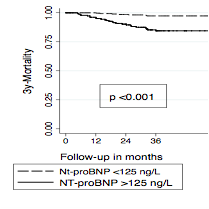Session Information
Date: Sunday, November 8, 2015
Title: Systemic Sclerosis, Fibrosing Syndromes and Raynaud's - Clinical Aspects and Therapeutics Poster I
Session Type: ACR Poster Session A
Session Time: 9:00AM-11:00AM
Background/Purpose: Heart involvement both of
primary origin or secondary to lung disease is a key contributor to morbidity
and mortality in systemic sclerosis (SSc). While Echocardiography is a primary tool of
assessment in this setting, we have already reported that N-terminal Pro-brain
natriuretic peptide (NT-proBNP) allows
the reliable detection of reduced left and/or right ventricular ejection
fraction (LVEF and RVEF) and of pulmonary arterial hypertension (PAH). Whereas
NT-proBNP could predict mortality is SSc patients remains unknown.
study that included 523 patients with SSc: mean age = 54±13 years, 323 women (61.8%), 8±9 years disease
duration, diffuse cutaneous form in 168.
Plasma NT-proBNP was measured at baseline and patients were followed up annually
to 5 years.
baseline, 37 patients had manifestations of cardiac involvement, including 17
with proven (PAH) and 20 with reduced LVEF<55%. 32 patients (7%) died within
3 years of follow-up and 59 (16%) within 5 years. NT-proBNP
concentration was increased in SSc who died within 3 years versus those who
survived (203 [129-514] versus 88 [47-167] ng/l respectively, p<0.001). Similar results were observed for a
5-years follow-up period (p<0.001), or after the exclusion of patients
having PAH or reduced LVEF at baseline (p=0.001). Using a 125 ng/l cutoff value,
NT-proBNP reliably predicts 3-y and 5-y mortality (respective sensitivities of 78.1%
and 59.3%) (Figure 1). Negative predictive values for
3-y and 5-y mortality of a NT-proBNP concentration <125 ng/l were 97.6% and 90.0%
respectively). Receiver-operating-characteristics analysis confirmed that
NT-proBNP reliably predicted mortality (area under the curve 0.76). Of the most
interest, in multivariate analyses, elevated NT-proBNP was an independent
predictor of mortality at 3 years (p=0.03) such as pulmonary functional tests
(FVC, p=0.008 and DLCO/VA, p= 0.01).
independently predicted 3- and 5-years mortality in patients with SSc. Remarkably, our
data show that NT-proBNP levels provide additional prognostic information that
is independent of the one offered by common characteristics of the disease. Therefore,
NT-proBNP may be considered as a first-line tool for prognostic assessment in
SSc patients. This adverse prognostic marker might be considered as a potential
eligibility criterion for risk stratifying SSc patients and for investigational
or high-risk interventions.
Figure 1 : Kaplan
Meier representation of 3y mortality according to NT-proBNP concentration (cox
model for analysis)
To cite this abstract in AMA style:
Meune C, Komocsi A, Vettori S, Hachulla E, Avouac J, Hunzelmann N, Distler JH, Allanore Y. Natriuretic Peptide Predicts Mortality in Systemic Sclerosis [abstract]. Arthritis Rheumatol. 2015; 67 (suppl 10). https://acrabstracts.org/abstract/natriuretic-peptide-predicts-mortality-in-systemic-sclerosis/. Accessed .« Back to 2015 ACR/ARHP Annual Meeting
ACR Meeting Abstracts - https://acrabstracts.org/abstract/natriuretic-peptide-predicts-mortality-in-systemic-sclerosis/

